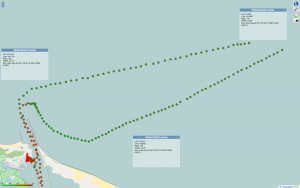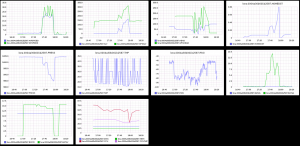Our research conducted in the MILA laboratory was mainly aimed at exploring how well LoRaWAN could work in maritime conditions and what would be the maximum possible range of network operations. For the experiment one gateway was installed with the antenna at the marina in the Górki Zachodnie. Measurement campaigns were carried out on the part of the Gdansk Bay (towards the Vistula River estuary in Mikoszewo) (Figure 6) and on the Vistula River itself, towards the Pontoon Bridge to Sobieszewo Island. Values of water temperature measured in the area of interests shown in Figure 6, ranged from 21.81 °C in the basin of the marina (point 1 ) to about 20.14 ° C in the Vistula estuary (point 2) down to 19.06 ° C (point 3) where communication with the getaway was finally lost. At the same Figure measurement points, the signal strength (RSSI) was -74 (point 1), -103 (point 2) and -113 (point 3). The furthest recorded point was about 6.5 km from the gateway. Clearly nominated range of 20 km could not be reached. However, it should be noted that for technical reasons, it was not possible to install a roof antenna or a high mast on a building in the marina. In fact, our provisioned antenna was installed on the first floor at the building, so that it interfere with the masts of the yachts in the harbor, the surrounding trees, other obstacles and probably the building itself. During the experiments, an external antenna with a gain of -6 dBi was connected to the gateway. No studies with higher gain antennas were attempted because of their size (a length over 3m), which would require additional lightning protection system to be designed separately.
Our research during the next experiment included an unmanned aircraft to test how LoRaWAN would behave at higher speeds and with more data to send. In the previous experiment, the device sent only one value, which along with the geographic coordinates implied only three values. In second experiment as many as 28 values plus geographical coordinates were sent. Since the LoRaWAN network does not allow the transmission of such a large datagram, the data was divided into four-variable packets for one-time sending. When experimenting with aircraft, a temporary installation was deployed on the ground with the same antenna as in previous studies with the yacht. Airplane remotely controlled from the ground, flew many times along a rectangular route. In each subsequent flight, both, the side of the rectangle and the height of the flight were gradually increased. This allowed us to do measurements and attempt data transfer at various flight parameters. The biggest recorded distance was about 1 km, which in practice is a physical limit for the pilot to control the plane from the ground without loosing it from sight. The highest recorded altitude achieved during the tests was about 150 m above the ground level. The next step was to check that a higher flight speed did not cause any interruption to the network. The plane was sped up in a flat dive and after a while it reached a speed of about 58 knots (110 km / h). During the experiments, there was no sign of loss of signal (a minimum recorded RSSI value was -97).


Leave a Reply